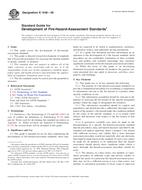1.1 This guide covers the development of fire-hazard-assessment standards.
1.2 This guide is directed toward development of standards that will provide procedures for assessing fire hazards harmful to people, animals, or property.
1.3 This standard does not purport to address all of the safety concerns, if any, associated with its use. It is the responsibility of the user of this standard to establish appropriate safety and health practices and determine the applicability of regulatory limitations prior to use.
1.4 This fire standard cannot be used to provide quantitative measures.
X3.1.1 This is an example of a fire hazard assessment standard written in accordance with Guide E 1546. It is intended solely for the purpose of illustrating the application of Guide E 1546 and so assisting in the development of fire-hazard-assessment standards. It is not to be used as a fire-hazard-assessment standard itself.
X3.1.1.1 As an example of a standard developed in accordance with Guide E 1546, this document is itself a more detailed guide to the format and content of a fire-hazard-assessment standard. For this reason, this document will refer to itself as both an “example standard“ and a “guide.“ The term “example standard“ will be used in any passage where a free-standing standard would refer to itself as a “standard.“
X3.1.1.2 A fire-hazard-assessment standard, or any other performance-based standard, is useful if there are new technologies or unusual designs whose associated fire hazards cannot be adequately measured by existing test-method-based standards; or if the goals of existing codes, standards, and regulations can be met more flexibly or less expensively by new technologies or designs that would not be acceptable under existing codes, standards, or regulations but could be shown to achieve the goals. Because existing codes, standards, and regulations typically do not state their goals in measureable form, suitable for engineering analysis, suitable goals that express the intent of the code, standard, or regulation must be developed by those responsible for safety. Those individuals have not controlled the specification of goals and associated evaluation criteria in this example standard, which is the principal reason that it is to be used as a guide and example and not as a standard for the subject product.
X3.1.1.3 Because this is an example and not a finished standard for use, the evaluation criteria, scenarios, assumptions, and models proposed must be regarded only as plausible, workable candidates that illustrate the structure and content of a fire-hazard-assessment standard. They do not all have consensus support as final choices for a standard ready for use.
X3.1.2 This example standard addresses fire-hazard assessment of floor coverings installed on the floor areas of buildings used as health-care occupancies. Paragraph X3.3.2.1 defines health-care occupancies, and Paragraphs X3.3.2.2 and X3.3.2.3 specify the types of health care occupancies addressed by this example standard. This example standard does not address floor coverings installed on walls, ceilings, stairs, or in occupancies other than health care.
X3.1.3 Floor coverings include carpets, carpet tiles, wood flooring, resilient flooring, and cast-in-place materials. Underlayments and previously installed floor coverings are included in the analysis as part of the floor covering.
X3.1.4 Floor coverings may be formed in place, attached by adhesive, adhesive tape, mechanical devices such as nails, or be unattached to the subfloor.
X3.1.5 This example standard addresses fire hazard, defined as loss of life at the fire scene, which is the measure of harm to be used. Section 6 identifies evaluation criteria to be used in determining that occupants are not exposed to fire effects sufficient to cause death.
X3.1.6 This example standard addresses fire hazards resulting from involvement of floor coverings in fires. The fire scenarios of concern, defined in detail in a later section, have been chosen to represent both common and severe scenarios in which floor coverings play a significant role in the development of a fire hazard to life, either as the first combustible item ignited or as a major factor in the growth or spread of fire. Each scenario description includes a discussion of the reasons for inclusion of the scenario.
X3.1.6.1 Reported fires involving significant contribution from floor coverings in health-care occupancies have been extremely rare for many years, and their associated losses are a small share of the total fire losses in health-care occupancies, which are themselves a small share of the total fire problem. Therefore, the assessment procedures described here are not to be used to supplement existing codes, standards, and regulations, which have proven fully adequate to provide safety from fire for floor coverings in health-care occupancies. A fire hazard assessment is to be used only to establish equivalency with the existing codes, standards, and regulation.
X3.1.7 For each scenario, this example standard provides examples of test methods or calculation procedures which can be used to assess the evaluation criteria for the floor-covering product.
Product Details
- Published:
- 01/15/2009
- Number of Pages:
- 21
- File Size:
- 1 file , 290 KB
- Redline File Size:
- 2 files , 530 KB
